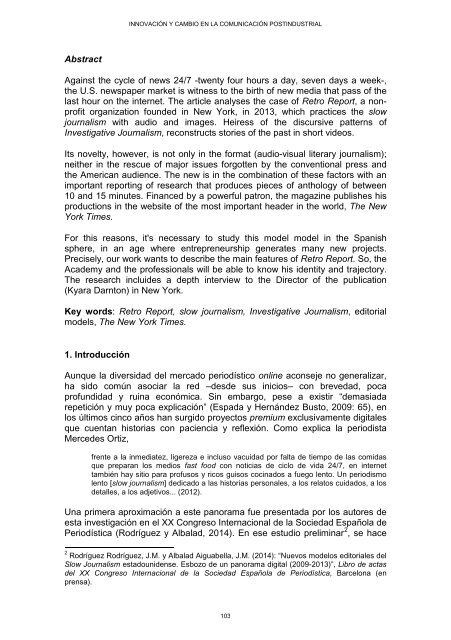libro2015
libro2015
libro2015
Create successful ePaper yourself
Turn your PDF publications into a flip-book with our unique Google optimized e-Paper software.
INNOVACIÓN Y CAMBIO EN LA COMUNICACIÓN POSTINDUSTRIAL<br />
Abstract<br />
Against the cycle of news 24/7 -twenty four hours a day, seven days a week-,<br />
the U.S. newspaper market is witness to the birth of new media that pass of the<br />
last hour on the internet. The article analyses the case of Retro Report, a nonprofit<br />
organization founded in New York, in 2013, which practices the slow<br />
journalism with audio and images. Heiress of the discursive patterns of<br />
Investigative Journalism, reconstructs stories of the past in short videos.<br />
Its novelty, however, is not only in the format (audio-visual literary journalism);<br />
neither in the rescue of major issues forgotten by the conventional press and<br />
the American audience. The new is in the combination of these factors with an<br />
important reporting of research that produces pieces of anthology of between<br />
10 and 15 minutes. Financed by a powerful patron, the magazine publishes his<br />
productions in the website of the most important header in the world, The New<br />
York Times.<br />
For this reasons, it's necessary to study this model model in the Spanish<br />
sphere, in an age where entrepreneurship generates many new projects.<br />
Precisely, our work wants to describe the main features of Retro Report. So, the<br />
Academy and the professionals will be able to know his identity and trajectory.<br />
The research incluides a depth interview to the Director of the publication<br />
(Kyara Darnton) in New York.<br />
Key words: Retro Report, slow journalism, Investigative Journalism, editorial<br />
models, The New York Times.<br />
1. Introducción<br />
Aunque la diversidad del mercado periodístico online aconseje no generalizar,<br />
ha sido común asociar la red –desde sus inicios– con brevedad, poca<br />
profundidad y ruina económica. Sin embargo, pese a existir “demasiada<br />
repetición y muy poca explicación” (Espada y Hernández Busto, 2009: 65), en<br />
los últimos cinco años han surgido proyectos premium exclusivamente digitales<br />
que cuentan historias con paciencia y reflexión. Como explica la periodista<br />
Mercedes Ortiz,<br />
frente a la inmediatez, ligereza e incluso vacuidad por falta de tiempo de las comidas<br />
que preparan los medios fast food con noticias de ciclo de vida 24/7, en internet<br />
también hay sitio para profusos y ricos guisos cocinados a fuego lento. Un periodismo<br />
lento [slow journalism] dedicado a las historias personales, a los relatos cuidados, a los<br />
detalles, a los adjetivos... (2012).<br />
Una primera aproximación a este panorama fue presentada por los autores de<br />
esta investigación en el XX Congreso Internacional de la Sociedad Española de<br />
Periodística (Rodríguez y Albalad, 2014). En ese estudio preliminar 2 , se hace<br />
2 Rodríguez Rodríguez, J.M. y Albalad Aiguabella, J.M. (2014): “Nuevos modelos editoriales del<br />
Slow Journalism estadounidense. Esbozo de un panorama digital (2009-2013)”, Libro de actas<br />
del XX Congreso Internacional de la Sociedad Española de Periodística, Barcelona (en<br />
prensa).<br />
103




